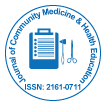The Community Hospital Revolution: Advancing Equitable Health through Integration
Received: 07-Mar-2025 / Manuscript No. jcmhe-25-167356 / Editor assigned: 10-Mar-2025 / PreQC No. jcmhe-25-167356 (PQ) / Reviewed: 24-Mar-2025 / QC No. jcmhe-25-167356 / Revised: 31-Mar-2025 / Manuscript No. jcmhe-25-167356 (R) / Published Date: 07-Apr-2025
Description
Community hospitals, traditionally viewed as facilities for delivering primary and acute care, are emerging as essential factors in the broader effort to promote population health. In both highincome and low- and middle-income countries, health systems are being challenged by the growing burden of chronic diseases, rising healthcare costs, demographic shifts and persistent health disparities. In response, the health policy narrative is shifting toward prevention, early intervention and integrated care. Community hospitals are uniquely positioned to drive this transformation, yet their potential remains underutilized. Expanding their role beyond episodic treatment to include population health promotion is not only timely it is essential for achieving sustainable, equitable health outcomes worldwide.
Historically, the mission of community hospitals has centered on the diagnosis and treatment of illness. While this remains a critical function, it is increasingly evident that the determinants of health extend far beyond the hospital walls. Factors such as housing, education, nutrition, income, environment and social support significantly influence population health outcomes. Community hospitals, by virtue of their proximity to the populations they serve and their trust within local communities, are well-placed to address these determinants in partnership with public health agencies, non-profits, schools and local governments.
One compelling reason to expand the role of community hospitals is the urgent need for preventive care infrastructure. Chronic diseases such as diabetes, cardiovascular disease and respiratory conditions are rising globally, contributing to premature mortality and economic strain. Yet, many health systems remain reactive rather than proactive. Community hospitals can serve as hubs for preventive services such as routine screenings, vaccination programs, nutrition counseling and smoking cessation support thus shifting the focus from treatment to prevention. Embedding these services in local hospitals can improve access, especially in underserved and rural communities where primary care resources are scarce.
Moreover, community hospitals can play a pivotal role in managing transitions of care and reducing hospital readmissions, which are both costly and indicative of system inefficiencies. By integrating with community-based providers, care coordinators and home health services, these institutions can support patients in managing chronic conditions after discharge. This integration requires a reimagining of care delivery models that extend beyond hospital walls and prioritize follow-up, medication adherence, patient education and social services. When implemented effectively, such models not only improve patient outcomes but also reduce the financial burden on health systems.
In many countries, the COVID-19 pandemic highlighted the importance of local health infrastructure and community trust in managing public health emergencies. Community hospitals were on the frontlines of the pandemic response, offering testing, triage, patient education and vaccination. Their responsiveness and community engagement during this crisis underscore their potential as anchors in population health systems. Building on this momentum, policymakers should empower these institutions with the tools, resources and governance models necessary to sustain a population health mission beyond crisis periods.
To fully expand the role of community hospitals in population health, several systemic changes are needed. First, financing structures must be realigned to incentivize prevention and community-based care. Current reimbursement models often reward volume over value, discouraging investments in outreach, education and care coordination. Transitioning to value-based payment models that reward improved population outcomes can enable community hospitals to adopt broader roles without compromising financial viability.
Second, workforce development must be prioritized. Expanding the mission of community hospitals requires interdisciplinary teams equipped to address both medical and social needs. This includes not only physicians and nurses but also social workers, community health workers, behavioral health specialists and health educators. Training these professionals to work collaboratively across sectors is essential for delivering integrated, culturally competent care that reflects community priorities.
Third, data integration and information-sharing are critical. Community hospitals must have access to population-level data to identify health trends, target interventions and evaluate impact. Interoperable health information systems that connect hospitals with public health departments, primary care providers and social services will support a more coordinated approach to care. Moreover, using data to engage communities by sharing transparent, actionable insights can build trust and foster participation in health initiatives.
In conclusion, expanding the role of community hospitals to promote population health is both a practical and moral imperative. These institutions are more than places of treatment they are pillars of their communities, uniquely positioned to address the broad range of factors that influence health. By redefining their mission, investing in integrated care models and fostering partnerships with public and community sectors, community hospitals can lead the way in building healthier, more resilient societies. It is time to unlock their full potential, not only as providers of care but as champions of community well-being.
Citation: Grant O. (2025) The Community Hospital Revolution: Advancing Equitable Health through Integration. J Community Med Health Educ 15:924.
Copyright: © 2025 Grant O. This is an open-access article distributed under the terms of the Creative Commons Attribution License, which permits restricted use, distribution, and reproduction in any medium, provided the original author and source are credited.
Select your language of interest to view the total content in your interested language
Share This Article
Recommended Journals
Open Access Journals
Article Usage
- Total views: 385
- [From(publication date): 0-0 - Dec 08, 2025]
- Breakdown by view type
- HTML page views: 303
- PDF downloads: 82
